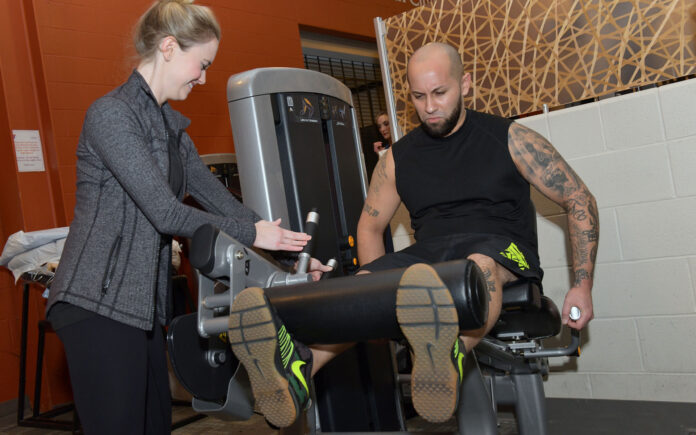By Tyler Fenwick
Robert Owen, the British owner of a textile manufacturing plant who used his wealth to start a utopian socialist community in New Harmony, coined a slogan in 1817 that went on to inform labor rights activists of the 19th and 20th centuries:
“Eight hours labour, eight hours recreation, eight hours rest,”
chopping a 24-hour day into three equal parts. Full-time workers in America today do spend about eight hours a day at work — 8.56 on weekdays in 2017, according to the U.S. Department of Labor Statistics — but that doesn’t mean those hours spent at work have to be exclusively for labor. Some employers in Indiana are encouraging their workers to be proactive about their health and well-being through employee wellness programs.
The logic behind these programs is simple: A healthier employee is a happier employee, and a happier employee is a more productive employee. From monetary incentives for weight loss to paid time at an in-house gym, employers are finding a wide range of programs to boost company morale through health and fitness. Ultimately, they’re banking on a wellness program to improve retention rates and cut back on sick leave, as well as lower health care costs.
One such program exists at Accurate Manufactured Products Group, an Indianapolis company that makes fasteners. There, trainer Kelsey Meyer meets twice a week with employees for an hour total in an on-site gym to work out and answer questions about fitness and nutrition. Time sheets won’t reflect the hour in the gym, and employees don’t have to worry about balancing a lunch break with working out. They’re still considered on the clock when they meet with Meyer. Even for those who don’t have drastic health goals, it’s at least a chance to be physically active and de-stress without sacrificing pay.
“That’s probably the biggest thing,” Meyer says. “Some of these people’s jobs here are pretty monotonous or pretty physical. … They do the same thing all day, so it’s nice to have a mental break during the day.”
Meyer is employed by Hoffacker Health and Fitness, which offers training and education to individuals and entire companies. The Age Successfully program is what sends trainers like Meyer to companies. Steve Cosgrove, who owns half of Hoffacker Health and Fitness and basically controls the business as a managing partner, wouldn’t say exactly how many companies use Age Successfully, but did say it’s less than 10.
Cosgrove is on the board of directors at Accurate Manufactured Products Group and says the company was dealing with out-of-control health care costs when it implemented the Age Successfully program. He has been involved in manufacturing as an investor and operator and saw the need for employers to strengthen their stake in the health of their workers.
“We need to own as much responsibility for the health of our employees as we possibly can,” Cosgrove says.
The results are showing up. Eudilio Morales has been working at Accurate Manufactured Products Group for about eight years. As a receiving manager, Morales handles duties such as unloading trucks, which means he sometimes has to lift boxes as heavy as 70 pounds. That work took its toll on his back, and Morales says it got bad enough to force him to wear a brace.
“Coming in here, I didn’t really care much for my health or my eating habits,” he says. “Once we started the wellness program, they brainwash it into your head: You’re supposed to be this healthy, you’re supposed to drink this much water, you should be working out. And it starts to click.”
Meyer said it seemed as if Morales was unsure of the program at first because it was just adding more physical work to a job that was already physically demanding, but he’s loosened up to the idea of having a physical job and working out.
“I think he’s seen the benefits of feeling better when he’s working and having a better attitude,” Meyer says.
A fitness routine — including stretching and a short massage at the end of sessions — proved to be very different from lifting 70-pound boxes. Four years later, Morales doesn’t wear a back brace anymore. And although he admits to not being very disciplined with the various diets he tries, Morales said he has learned more about what nutrition can do for his health.
“It takes stress off of your mind, just to get out here for a little while and run around,” Morales says. “It helps alleviate stress.”
The employee wellness program has also benefited Adam Sutton. He’s a machinist at Accurate Manufactured Products Group, working with Swiss lathes, which he says makes for a tight work environment. Sutton says he was out of shape and smoking when the program began, so he decided to use that as a starting point to change his life. After 15 years of smoking cigarettes, Sutton quit, and he lost 30 to 40 pounds. He’s also a runner now, getting his marathon time down to 3 hours, 34 minutes in 2018.
“I don’t think I ever would have done it,” Sutton says of getting his life turned around. “I don’t think I ever would have started. Then if you’re ever feeling tired and like you want to hang it up, you get to come back in here and re-motivate yourself.”
Figuring out the benefit of workplace wellness programs usually isn’t as simple as calculating dollars and cents. There are measurements in areas such as health care costs and worker productivity that can shed some light on a program’s usefulness — and in some cases these are rather convincing signs that employers are benefiting from healthier workers — but there are other markers to consider.
Deaconess Health System is a large network of health service providers that spans 26 counties in three states, including southwest Indiana in Evansville. Deaconess implemented its wellness program, open to all employees and their spouses, about 10 years ago and has put an emphasis on preventive care and catching potential health issues early.
Employees get a health reimbursement account (different from a health savings account) and can earn money into that account by doing a wellness screening. These screenings take basic body measurements and blood work, which health counselors use to help employees. Workers can do the screenings on company time, and employees can then use that information and counseling to branch out into other parts of the wellness program on their own time. Close to 80 percent of employees get a health screening, according to Jenny Hurley, a practice manager at Deaconess Clinic in Evansville.
“That’s where we get about 10 minutes to talk with them about all of our programming, so they get to hear annually all the new things we’re starting,” Hurley says. “We place a seed at that time.”
Hurley says the health screenings have caught issues such as pre-diabetes, allowing employees to connect with an expert before it becomes more serious. The wellness program also spotlights weight loss with competitions. Hurley says their biggest challenge, called “weight wars,” is similar to what’s seen on the TV show “The Biggest Loser.” With just over 6,000 employees, it’s easy to see why companies like Deaconess would prioritize preventive care, rather than waiting until the problem is full-blown.
In some cases, though, employers can actually quantify how they’re benefiting from a wellness program for their workers. At the YMCA of Greater Indianapolis, wellness advisors give annual plans to full-time employees after a health assessment. About 90 percent of employees with medical coverage participate in the assessment, according to Kathy Moreland, vice president of human resources.
Employees of companies that partner with the YMCA also get access to wellness advisors, who develop health plans the same way they do with actual YMCA employees. The YMCA of Greater Indianapolis has about 170 corporate partners, according to Moreland, including hotels, transportation providers and school districts.
Advisors, who are employed by the YMCA, break down a wellness plan into six months for both their own employees and the employees of corporate partners, focusing on one healthy habit per month. Moreland says this has helped keep premium increases under 5 percent for most of the last 16 years.
But it’s not as though hard numbers are all that matter when it comes to improving the health of employees. Asked how the Age Successfully program has affected health care costs at Accurate Manufactured Products Group, Cosgrove says it’s difficult to calculate that accurately because of how many variables are involved.
“What I can prove is we can improve morale tremendously,” Cosgrove says. “We can help improve employee retention. We can help avoid injury.”
For a company to implement Age Successfully, Cosgrove says the low end on the cost scale is $2,000 a year per employee, and it can go up to $3,200, depending on what services the program provides. But Cosgrove says companies weighing an employee wellness program should focus more on maximizing profitability — through retention, satisfaction and less time required off for injury — rather than a raw cost.
“If you’re measuring it strictly by cost I don’t think you would hire us,” he says.
Not every employee wellness program is as immersive as the ones found at Accurate Manufactured Products Group or Deaconess Health System. For smaller employers that can’t stretch their budget to include a full-time contracted trainer, or for companies that want more periodic engagement with a program, there are options like Longevity Fitness in Fort Wayne.
Erin Long, the founder of Longevity Fitness and one of its trainers, says most of what her wellness company does is one-time events by appointment. These include lunch-and-learns, where she or another trainer goes to a company to talk to a group of employees about physical health, meditation, relaxation, etc. Longevity Fitness also does weight-loss competitions throughout the year to match seasonal demands: usually one around the end of the year for people to kickstart a New Year’s resolution, one in the spring in preparation for summer and one around the holidays.
“The absentee rate is lower when you’re providing some kind of wellness for your employees,” Long says. “It makes them feel better and gives them the opportunity to get a workout done during the workday instead of having to go to a gym before or after work.”
According to Long, sending a trainer to a company for a one-hour fitness class costs $60 to $70, depending on where the facility is and how many employees are involved. Longevity Fitness also has a workout facility on site, and employees at participating companies get a discount to use it.
“Normally it doesn’t take too much convincing,” Long says of partnering with companies, “because they know the studies, they know the benefits, that employees who choose to work out and take care of themselves are going to be better employees.” I










